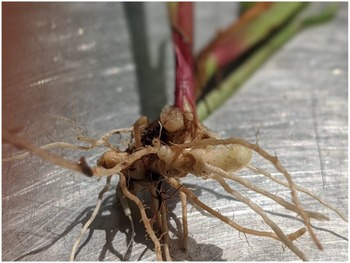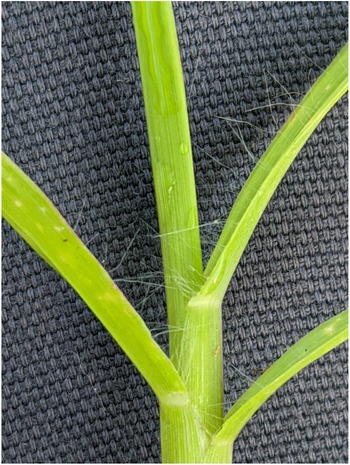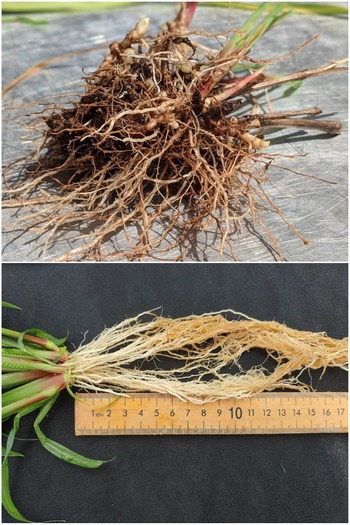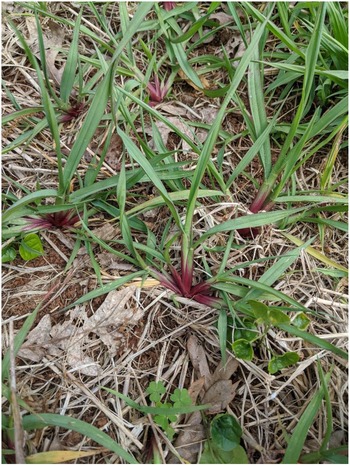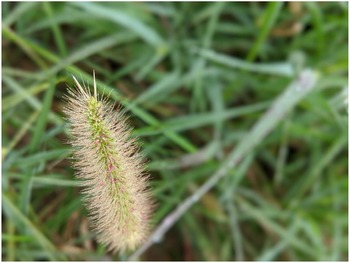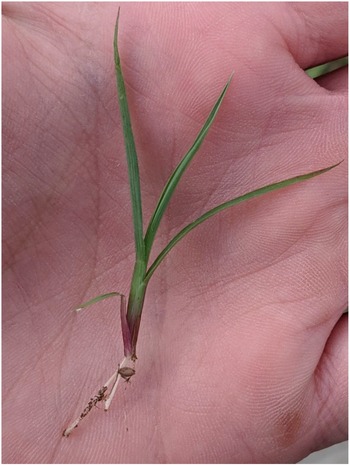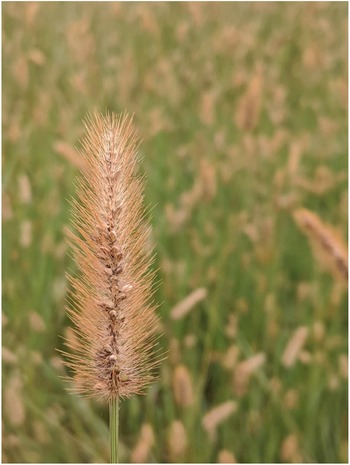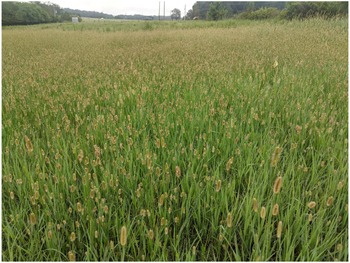If you deal with a fox, think of his tricks. – Jean De La Fontaine
Be like the fox who makes more tracks than necessary, some in the wrong direction. Practice resurrection. – Wendell Berry
The fields are bleeding
It was the age the foxes came for the fields
We were bleeding as we bowed to kneel
And pray for mercy, pray for mercy – Brooke Fraser
Introduction
The Setaria grass genus is made up of 125 individual species (Dekker Reference Dekker2003). Belonging to the Poaceae family, Panicoideae subfamily, and the Paniceae tribe, the Setaria genus has been very difficult to classify due to the overlapping genetics of many species (Bennetzen et al. Reference Bennetzen, Schmutz, Wang, Percifield, Hawkins, Pontaroli, Estep, Feng, Vaugh, Grimwood, Jenkins, Barry, Lindquist, Hellsten, Deshpande, Wang, Wu, Mitros, Triplett, Yang, Ye, Mauro-Herrera, Wang, Li, Sharma, Sharma, Ronald, Panaud, Kellogg, Bruntnell, Doust, Tuskan, Rokhsar and Devos2012: Hu et al. Reference Hu, Mauro-Herrera and Doust2018; Wang et al. Reference Wang, Wendel and Dekker1995a). More than half of the Setaria species are native to Africa, whereas most of the remaining species are native to Europe and Asia. However, knotroot foxtail [Setaria parviflora (Poir.) Kerguélen] is the most widely distributed and diverse foxtail species native to tropical regions of North America (Barkworth et al. Reference Barkworth, Anderton, Capels, Long and Piep2007; Dekker Reference Dekker2003). Setaria species are included as some of North America’s most problematic weeds: yellow foxtail (Setaria pumila Poir. Roem. & Schult.), giant foxtail (Setaria faberi Herrm.), and green foxtail (Setaria viridis L. P. Beauv.), but this genus also contains a crop species of historical significance, including foxtail millet (Setaria italica L. P. Beauv.) (Dekker Reference Dekker2003). Knotroot foxtail is an erect, spreading perennial C4 grass species propagated by short rhizomes and seeds (Doust and Diao Reference Doust, Diao and Jorgensen2017). The name knotroot foxtail adequately describes the reproductive parts of this species because the inflorescence resembles that of a fox’s tail, and the rhizomes exhibit a distinct knotty appearance. The rhizomes are short, stubby, and form relatively shallow (<2.5 cm) in the soil profile (Figure 1) (Dekker Reference Dekker2003). Although knotroot foxtail occurs in various agronomic settings, it is more prevalent in minimally disturbed perennial cropping systems.
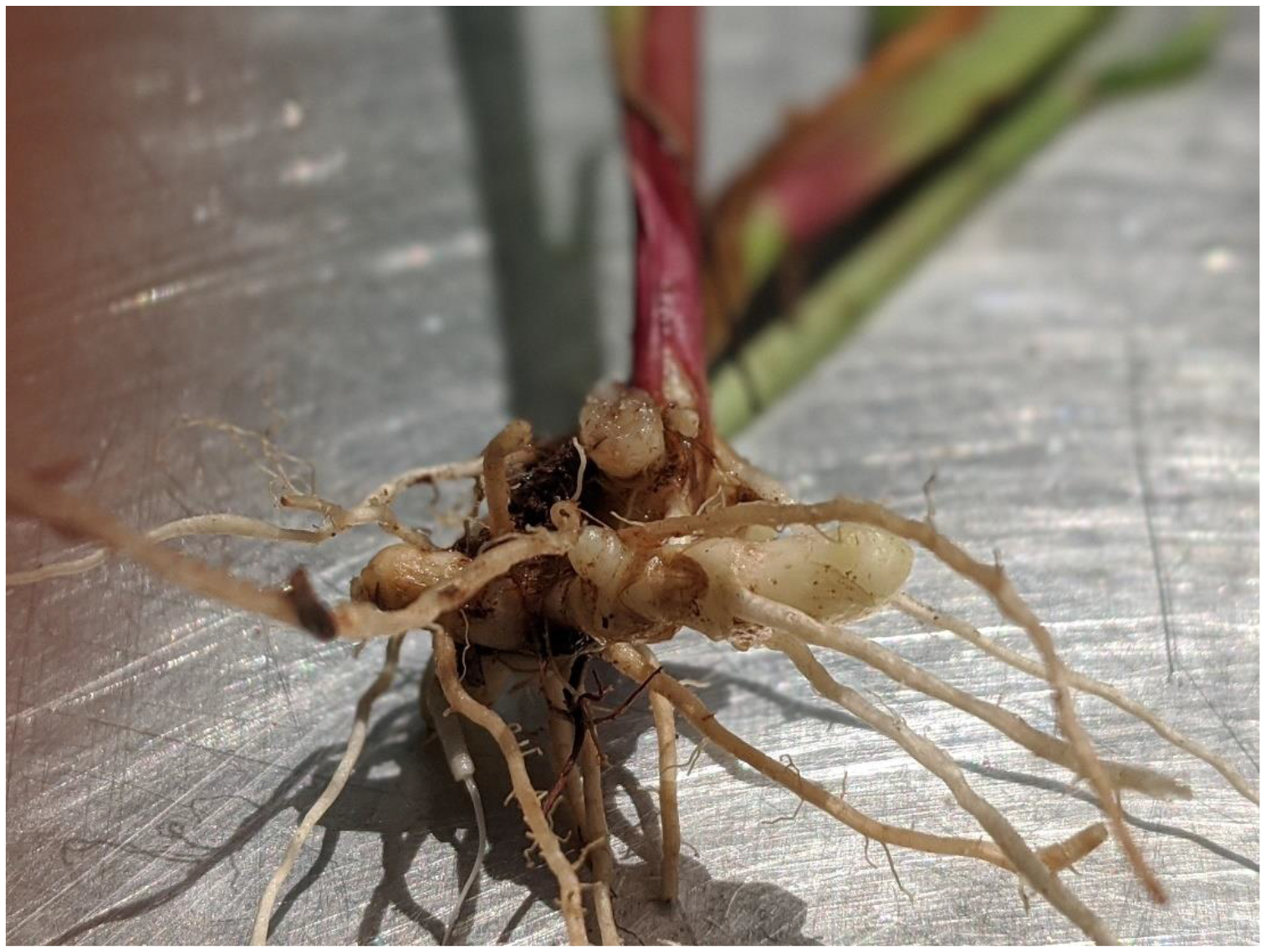
Figure 1. Rhizomes on a first-year knotroot foxtail [Setaria parviflora (Poir.) Kerguélen] developing during the season.
Throughout history, knotroot foxtail has been classified using multiple scientific names including Chaetochloa geniculata (Lam.) Millsp. & Chase, Chaetochloa imberbis (Poir.) Scribn., Cenchrus parviflora Poiret, Chaetochloa perennis (Beal) E. P. Bicknell Bull., Panicum geniculatum Lam., Setaria geniculata (Wild.) P. Beauv., nom. Illeg., Setaria garcillis Kunth (USDA-NRCS 2021), and many more (Gandhi and Barkworth Reference Gandhi and Barkworth2003). Although commonly referred to as knotroot foxtail, other common names include marsh bristlegrass, bristly grass, yellow bristlegrass, and knotroot bristlegrass (Bryson and DeFelice Reference Bryson and DeFelice2009). The current scientific name, Setaria parviflora, describes a grass with bristles (seta), connected with (aria) small (parvi) flowers (flora) (Smith Reference Smith1860; Zimdahl Reference Zimdahl1989).
Description
Identification of knotroot foxtail can be difficult because the aboveground identifying characteristics are nearly identical to those of yellow foxtail. Difficulty with identification is common because knotroot foxtail has been described as one of the most widespread and morphologically diverse Setaria species native to the North American continent, and knotroot foxtail has been known to cross-hybridize with yellow foxtail (Barkworth et al. Reference Barkworth, Anderton, Capels, Long and Piep2007; Doust and Diao Reference Doust, Diao and Jorgensen2017; Rominger Reference Rominger1962). However, yellow foxtail and knotroot foxtail differ with respect to their lifecycle, reproductive morphology, panicle characteristics, and ligule size (Hubbard Reference Hubbard1954). Both species have hairy ligules and long hairs around the leaf base (Figure 2). The key distinguishing feature for knotroot foxtail is the presence of a rhizome, while yellow foxtail has fibrous roots (Figure 3). The focus of identification has varied over the years. Initially, yellow foxtail and knotroot foxtail were separated simply by their lifecycle (annual vs. perennial; Hitchcock Reference Hitchcock1935). In later accounts, these two species were separated by spikelet length (2 to 2.5 mm for knotroot foxtail compared with 3 mm for yellow foxtail), lower floret sexuality (staminate compared to neuter), and palea development (reduced compared to well developed) (Hitchcock and Chase Reference Hitchcock and Chase1950). Knotroot foxtail can grow upright or decumbent and reach heights of up to 1.2 m (Figure 4), whereas yellow foxtail growth is predominantly upright. Although knotroot foxtail is typically shorter than yellow foxtail, this characteristic is not reliable for identification purposes due to the effect of varying environmental conditions on plant growth (Bryson and DeFelice Reference Bryson and DeFelice2009). Leaf blades of knotroot foxtail have a scabrous, adaxial surface that ranges from 6.0 to 25.0 cm long with a width of 1.9 mm, whereas yellow foxtail has a slightly wider leaf blade (4 to 10 mm) (Barkworth et al. Reference Barkworth, Anderton, Capels, Long and Piep2007). Both yellow foxtail and knotroot foxtail are pubescent at the base of the leaf blade. Inflorescences of both yellow and knotroot foxtail are a cylindrical densely flowered panicle 3.0 to 10.0 cm long and 0.5 to 2.9 cm wide, with purple or yellow bristles 1 to 15 mm in length (Figure 5) for knotroot foxtail (Barkworth et al. Reference Barkworth, Anderton, Capels, Long and Piep2007; Bryson and DeFelice Reference Bryson and DeFelice2009) compared with a slightly longer panicle (3 to 15 cm) with shorter bristles 3 to 3.5 mm long on yellow foxtail. The base of knotroot foxtail plants is purple, which extends upward and eventually fades to green for the remainder of the leaf blade (Figure 6) (Barkworth et al. Reference Barkworth, Anderton, Capels, Long and Piep2007). Yellow foxtail can have a similar purple coloration at times but is less consistent than knotroot foxtail. Once pollinated and mature, the seed will shed a light-colored testa, which appears dark brown to black with gray stripes (Figure 7). Yellow foxtail seeds are also surrounded by a light-colored testa, but seeds tend to be lighter in color than knotroot foxtail when mature. Physical and morphological similarities are not surprising in the Setaria genus because most of the weedy foxtail species have low genetic diversity within species, especially in areas outside of a species native range, but significant variability species and populations (Wang et al. Reference Wang, Wendel and Dekker1995a).

Figure 2. Knotroot foxtail [Setaria parviflora (Poir.) Kerguélen] pubescence on the base of the leaf.

Figure 3. Knotroot foxtail root system showing developed perennial rhizomes (top) and yellow foxtail (bottom) showing fibrous roots.

Figure 4. Upright to decumbent growth habit of knotroot foxtail [Setaria parviflora (Poir.) Kerguélen] highlighting the distinctive purple base of this species.
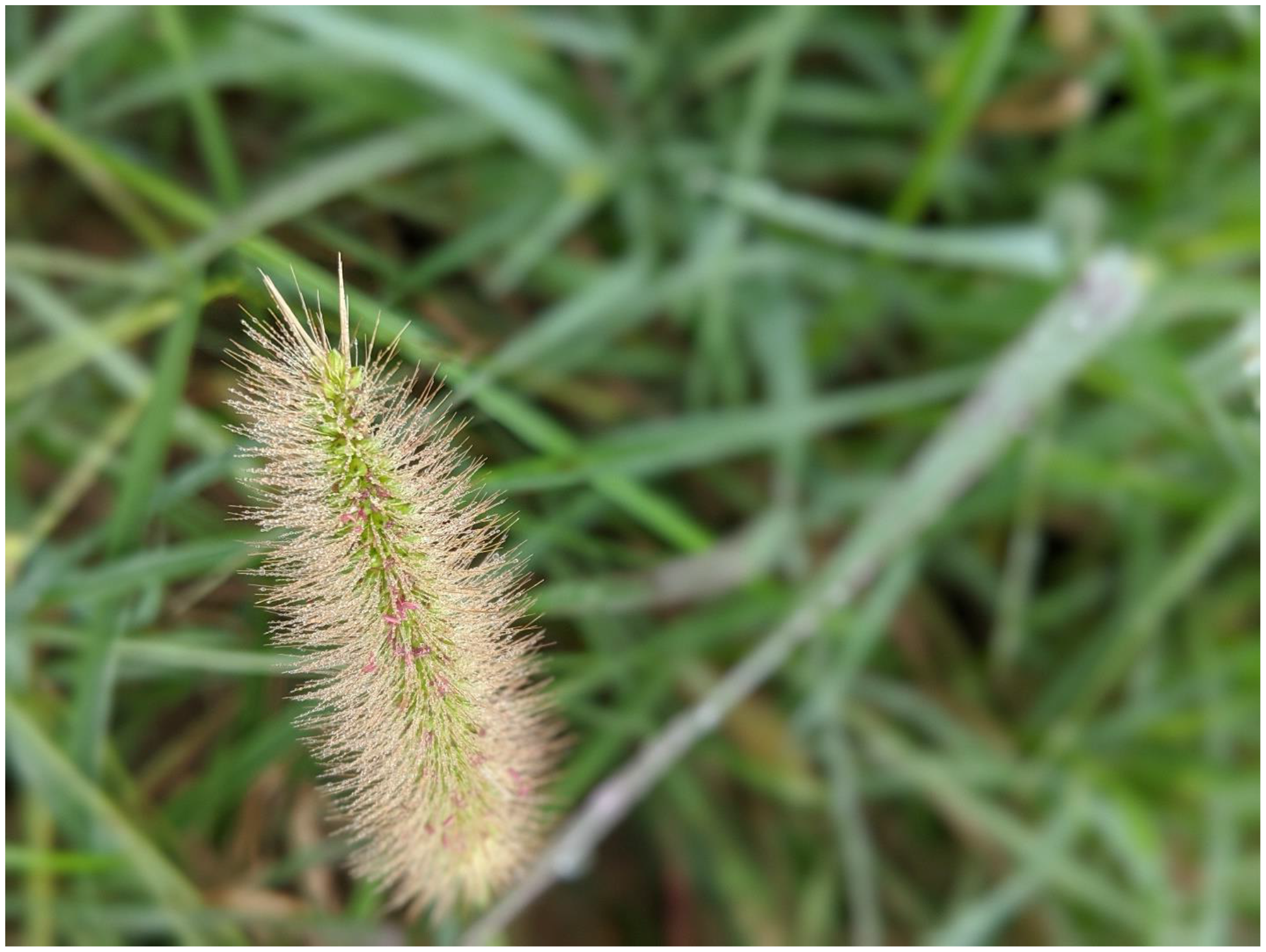
Figure 5. Early stages of seed head development in knotroot foxtail [Setaria parviflora (Poir.) Kerguélen] highlighting the purple anthers and developing bristles.

Figure 6. Knotroot foxtail [Setaria parviflora (Poir.) Kerguélen] seedling with purple coloration present above the crown and seed still attached to the root system.
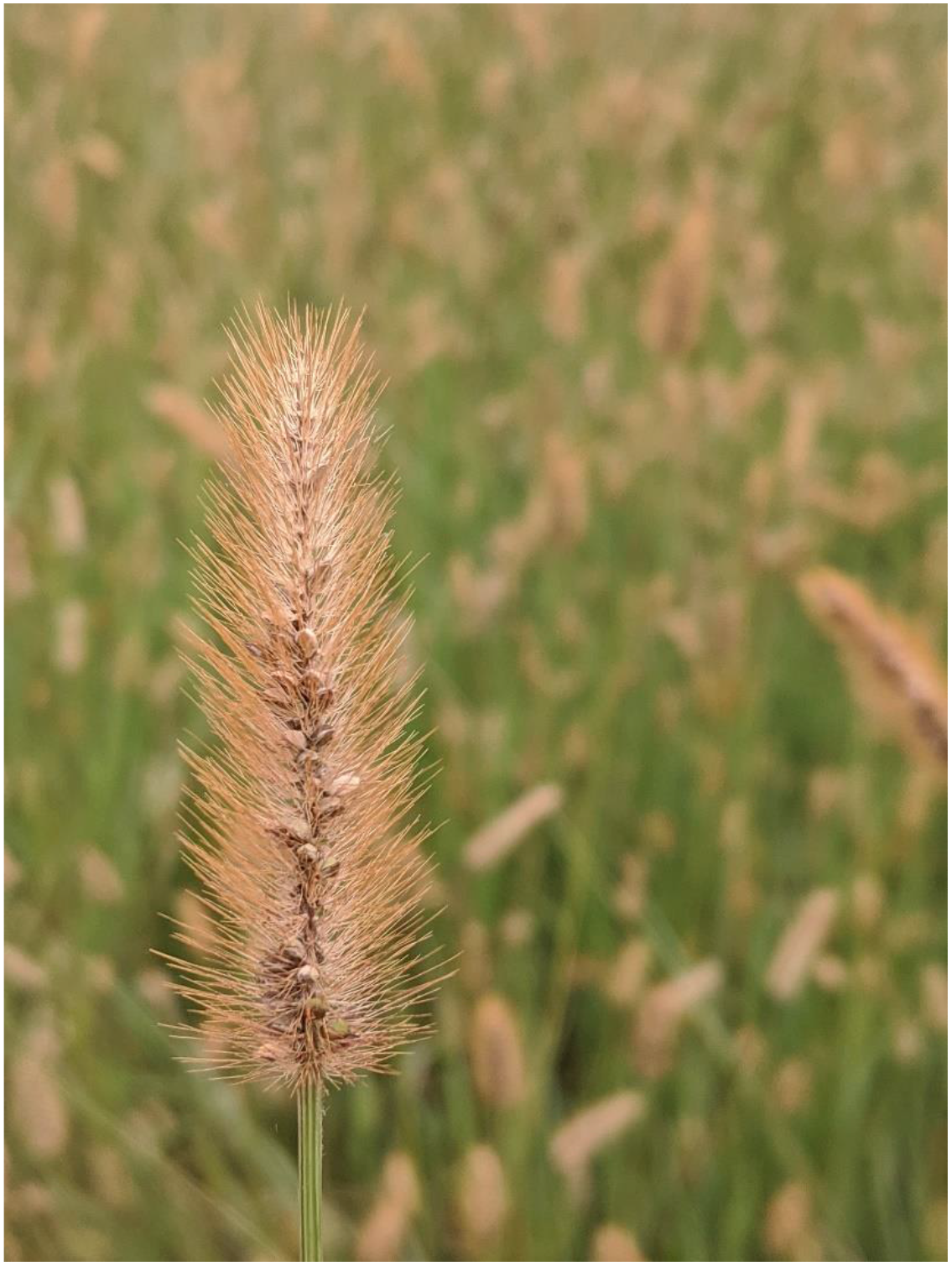
Figure 7. Mature knotroot foxtail [Setaria parviflora (Poir.) Kerguélen] seed head exhibiting early dehiscence.
History and Distribution
The Setaria genus is linked to five separate invasions across the globe (Dekker Reference Dekker2003). During the first Setaria invasion, some species moved from Africa to Eurasia and adapted to a wider range of climates. The second Setaria invasion included green foxtail and yellow foxtail, at which time both began to be domesticated. The third invasion is of specific importance, because Setaria species from Europe were brought to the Americas. Prior to this invasion, only knotroot foxtail existed in the Americas. Several sources indicate that knotroot foxtail was an important cereal grain crop to inhabitants of Mexico (Moerman Reference Moerman1998; Yanovsky Reference Yanovsky1936). It is believed that yellow foxtail was brought by primitive humans crossing the Bering Straits land bridge from Asia to the Americas around 10,000 to 20,000 BCE and became widely distributed across North and South America (Wang et al. Reference Wang, Wendel and Dekker1995a). Annual Setaria species (green foxtail, foxtail millet, yellow foxtail, hooked bristlegrass [Setaria verticillata]) were noted to be present in in the mid-19th century in agricultural fields, pastures, and orchards, but only hooked bristlegrass was mentioned as a weedy nuisance (Darlington Reference Darlington1847). The fourth invasion of Setaria came from a hybridization of Setaria faberi produced in China and introduced in New York City in the 1920s. In the next decade, this Setaria species was found in Pennsylvania and Missouri. Use of 2,4-D in cereal crops after World War II caused a weed population shift that allowed for a Setaria invasion in the United States. The fifth and current invasion started in the 1970s with the development of herbicide-resistant Setaria biotypes (Stoltenberg and Wiederholt Reference Stoltenbergg and Wiederholt1995; Thornhill and Dekker Reference Thornhill and Dekker1993; Volenberg and Stoltenberg Reference Volenberrg and Stoltenberg2002; Wang and Dekker Reference Wang and Dekker1995b).
The Setaria genus classified by Linnaeus and assumed to be domesticated in the Americas as a small grain around 9,000 BCE is believed to be knotroot foxtail (Dekker Reference Dekker2003; Hu et al. Reference Hu, Mauro-Herrera and Doust2018). It is thought to be native to tropical regions of the Americas with some evidence tying the evolution of knotroot foxtail to southern Brazil (Freitas-Sacchet et al. Reference Freitas-Sacchet, Boldrini and Born1984; Holm et al. Reference Holm, Doll, Holm, Pancho and Herberger1997). Its distribution occurs throughout most of the contiguous United States, excluding northern Plains states and the northeastern United States (Dekker Reference Dekker2004; Rominger Reference Rominger1962; USDA-NRCS 2021). Knotroot foxtail has spread across the globe in North and South America, Australia, Asia, the Middle East, Europe, Africa, and some of the Pacific Islands (Rominger Reference Rominger1962). Increasing levels of CO2 and rising global temperatures may further increase the range of knotroot foxtail, potentially making it more problematic (Chuine et al. Reference Chuine, Morin, Sonie, Collin, Fabreguettes, Defueldre, Salager and Roy2012).
Characteristics
Toxicity
Specific information on the toxicity of knotroot foxtail is unknown. However, other Setaria species can be toxic to horses due to the presence of oxalates in the foliage that can cause kidney failure. African bristlegrass [Setaria sphacelata (Schumach.) Stapf & C.E. Hubb. ex M.B. Moss] has been documented to cause kidney failure due to an accumulation of oxalates in domesticated animals (Rahman et al. Reference Rahman, Abdullah and Wan Khadijah2012). Feeding horses hay containing Setaria spp. causes equine stomatitis and ulcerative gingivitis compared with horses fed forage without Setaria contamination (Kutasi et al. Reference Kutasi, Andasofszky, Szenci, Bersenyi and Abonyi2018). Photosensitization and myocardiopathy can be caused by green and foxtail millet, although these symptoms are rare (Burrows and Tyrl Reference Burrows and Tyrl2001). More common with these species is mechanical injury. If plants with floral spikelets are grazed, ulcers can develop in the mouths of livestock (Burrows and Tyrl Reference Burrows and Tyrl2001; Israel et al. Reference Israel, Rhodes, Via and Miller2014). Horse owners are most concerned with knotroot foxtail and other Setaria species, due to mouth irritation from seedhead bristles (Israel et al. Reference Israel, Rhodes, Via and Miller2014).
Weediness and Control
Setaria spp. can occupy ecological niches in row crops, rights of way, and pasture settings (Bryson and DeFelice Reference Bryson and DeFelice2009; Darlington Reference Darlington1847) due to species adaptability to environmental conditions and a wide periodicity of germination (Manthey and Nalewaja Reference Manthey and Nalewaja1987; Norris and Schoner Reference Norris and Schoner1980; Stoller and Wax Reference Stoller and Wax1973). Early accounts indicate that Setaria species were adaptable to agricultural ecosystems as well as undisturbed sites (Darlington Reference Darlington1847), and knotroot foxtail was common in rice fields in South Carolina and Georgia (Elliott Reference Elliott1821). Infestation of yellow and green foxtail can reduce yield by 25% and 44%, respectively (Satchivi et al. Reference Satchivi, deBoer and Bell2017). Yield reduction in corn (Zea mays L.) can range from 10% to 14% and from 20% to 56% for yellow and green foxtail, respectively, while losses due to green foxtail in wheat can be 2% to 25% (Zimdahl Reference Zimdahl2004). Decades later, Setaria species continue to be problematic in both agricultural and non-crop settings such as forage fields or hayfields. Competitiveness of knotroot foxtail in non-crop areas is not well understood, but significant infestations can be prevalent (Figure 8). However, control of similar species within the same genus could elucidate strategies for knotroot foxtail control.

Figure 8. Severe infestation of yellow foxtail (Setaria pumila Poir. Roem. & Schult.) and knotroot foxtail [Setaria parviflora (Poir.) Kerguélen] in a pasture.
Control of weedy grass species in hay and pasture fields is necessary because infestations can reduce pasture productivity, hay quality, and overall value of the harvested forage (Burrows and Tyrl Reference Burrows and Tyrl2001). Livestock will graze Setaria species prior to forming a seed head, and these species have forage quality like that of alfalfa (Medicago sativa L.) and smooth brome (Bromus inermis Leyss.) (Lawrence et al. Reference Lawrence, Waller, Moser, Anderson and Larson1989). However, competition with perennial grasses often grown for forage {bermudagrass [Cynodon dactylon (L.) Pers.] and bahiagrass (Paspalum notatum Fluegg)} can reduce overall forage quality and forage stand longevity (Lawrence et al. Reference Lawrence, Waller, Moser, Anderson and Larson1989). There are specific challenges with managing Setaria species in pastures and hayfields production systems. In these production systems Setaria species germinate later than crabgrass, which is often targeted for control by producers (Manthey and Nalewaja Reference Manthey and Nalewaja1987; Oreja et al Reference Oreja, Batlla and de la Fuente2019). At the time of Setaria germination soil residual herbicide have reduced efficacy if herbicides are applied early in the season (Anonymous 2011, 2014, 2021b). Unlike commodity crop systems, hayfields and pastures are often cut or grazed multiple times throughout a growing season, opening the crop canopy and thus reducing the competitiveness of the crop (Hoveland et al. Reference Hoveland, Durham and Boutan1996; Piemeisel et al. Reference Piemeisel, Lawson and Carsner1951). Knotroot foxtail control is even more challenging due to the production and persistence of aggressive rhizomes (Griffin and Gunsaulis Reference Griffin and Gunsaulis2020; Wehtje et al. Reference Wehtje, Bostick and Dawkins2008). Efficacy of common pasture herbicides is typically reduced on rhizomatous grass weeds due to limitations in translocation that is necessary for control. Animals will graze Setaria species until the seed heads emerge, at which time they often avoid grazing knotroot foxtail and other Setaria species because they are less palatable, allowing them to further proliferate (Darlington Reference Darlington1847; Dennis Hancock, personal communication; McCullough Reference McCullough2016). Knotroot foxtail fecundity is similar to that of yellow foxtail, which is reported to yield 520 to 890 seeds per plant (Forcella et al. Reference Forcella, Colbach and Kegode2000). Furthermore, knotroot foxtail produces an abundance of seedheads shortly after mowing, further contributing to its persistence and spread. Differences in height between knotroot foxtail and more desirable warm-season forages such as bermudagrass and bahiagrass give this species a competitive advantage (Santelmann et al. Reference Santelmann, Meade and Peters1963). On roadsides, knotroot foxtail can reach heights of a meter or taller, reducing visibility and safety across thousands of miles of infrastructure in the southeastern United States (Israel et al. Reference Israel, Rhodes, Via and Miller2014). In Alabama, knotroot foxtail is a major weed pest of bahiagrass (Paspalum notatum Flüeggé) grown for seed, creating seed separation challenges at harvest due to similar maturity and seed size (Wehtje et al. Reference Wehtje, Bostick and Dawkins2008).
The perennial life cycle of knotroot foxtail further complicates control tactics. Plants that germinate from seed can be controlled with preemergence-applied herbicides such as indaziflam or pendimethalin, which are registered for use in some, but not all forage systems (Anonymous 2020b, 2021a; Dyer Reference Dyer2022). In-season postemergence (POST)-applied herbicides may damage actively growing forage grasses and result in ineffective knotroot foxtail control because target plants are often too large at the time of herbicide application. Peppers et al. (Reference Peppers, Goncalves and McElroy2020) observed excellent control (>95%) of yellow foxtail with pinoxaden applied to turfgrass at rates as low as 10 g ai ha−1. Quinclorac has also been used POST to control annual Setaria species in established bermudagrass pastures (McCullough Reference McCullough2022). Limited biological and ecological research regarding the control of knotroot foxtail has led to a poor understanding of long-term management. Recent research by Dyer (Reference Dyer2022) indicated that herbicides applied in the fall do not efficaciously control knotroot foxtail plants that have emerged from rhizomes (Anonymous 2015, 2019, 2020a). Lack of efficacious control coupled with multiple reproductive methods and a wide distribution has helped establish knotroot foxtail as a problematic weed across a wide range of agroecosystems.
Uses
Although knotroot foxtail is widely considered a weed (Austin Reference Austin2006), Setaria species are promising candidates as dryland small grains due to minimal nutrient and water requirements, short life cycles, smaller size, and the flexibility to grow as a grain or forage crop compared to traditional crops such as corn and sorghum, which require more moisture (Hu et al. Reference Hu, Mauro-Herrera and Doust2018). Fluctuating weather extremes due to climate change may further increase the use of Setaria species as grain crops because related species such as foxtail millet withstand drought conditions (Hu et al. Reference Hu, Mauro-Herrera and Doust2018). Historical documentation has confirmed that humans in Mexico did use knotroot foxtail seeds (Callen Reference Callen1963). In fact, knotroot foxtail was used by people in Mexico as early as 4000 to 3500 BCE and was grown and consumed well before the domestication of corn (Austin Reference Austin2006; Callen Reference Callen1967; Dewet and Harlan Reference Dewet and Harlan1975). In contrast, none of the multiple species of foxtails are stated as food sources of Native Americans (Yanovsky Reference Yanovsky1936). Vestal (Reference Vestal1952) reported only dermatological use of yellow foxtail seed by Navajo and Ramah Native American tribes. Although historical evidence documents knotroot foxtail use, aside from being a food source for wildlife, there are no other current uses for this species (Austin Reference Austin2006).
Other Setaria Species
In China, India, and Europe Setaria was domesticated to become the crop we know today as foxtail millet (Hu et al. Reference Hu, Mauro-Herrera and Doust2018). Foxtail millet is not a globally traded crop, but it is currently planted, harvested, and consumed by millions of people in Africa, India, and China (Hu et al. Reference Hu, Mauro-Herrera and Doust2018). Foxtail millet and green foxtail can be successfully hybridized, which suggests that foxtail millet may be a domesticated progeny of green foxtail (Dekker Reference Dekker2004; Li and Brutnell Reference Li and Brutnell2011). It is unclear whether foxtail millet was domesticated from green foxtail in China in synchrony with Europe’s domestication of green foxtail or whether foxtail millet was domesticated in China, was traded, and eventually found its way to Europe and other parts of the world (Hu et al. Reference Hu, Mauro-Herrera and Doust2018). It is important to note that research does not show that the two are separate species; rather that foxtail millet is a domesticated species of green foxtail (Bettinger et al. Reference Bettinger, Barton and Morgan2010; Hu et al. Reference Hu, Mauro-Herrera and Doust2018). The differences between the two species are found in a lack of dehiscence, larger seeds, taller plants, less vegetative branching, and more inflorescence branching of foxtail millet (Hu et al. Reference Hu, Mauro-Herrera and Doust2018). Undomesticated plants often attribute their success to an ability to freely disperse seeds. However, reducing dehiscence is a critical component for cereal grain yield. In foxtail millet, seed orientation on the inflorescence and seed cell size enables abscission zones to retain seeds longer when subjected to forces that green foxtail seed heads cannot endure (Hu et al. Reference Hu, Mauro-Herrera and Doust2018). This is one advantageous trait that foxtail millet retained during domestication from green foxtail (Hu et al Reference Hu, Mauro-Herrera and Doust2018). Plant height of foxtail millet and green foxtail are also notably different. The increased height of green foxtail may be attributed to the selection of abandoned tillers that did not produce inflorescences, as well as a desire for different crop heights that were dependent on use as a grain or forage (Hu et al. Reference Hu, Mauro-Herrera and Doust2018).
Can We Outsmart the Fox?
Little research has focused on the biology and control of knotroot foxtail (Dekker Reference Dekker2004; Dyer Reference Dyer2022; Griffin and Gunsaulis Reference Griffin and Gunsaulis2020; Israel et al. Reference Israel, Rhodes, Via and Miller2014). However, knotroot foxtail continues to be an issue in agricultural and non-crop systems. As this weed spreads and becomes more prevalent, efforts to manage it may need to become more creative and integrate multiple approaches. Knotroot foxtail is a sly weed, mimicking others of its kind, storing up for winter with its rhizomes. It’s sly in that you’re never looking for it, until you see its tail, popping up above the tall grass. Then it’s too late. The fox has already attacked.
Acknowledgments
No conflicts of interest have been declared. This review was funded by Bayer Environmental Science in the form of graduate student support funds.



